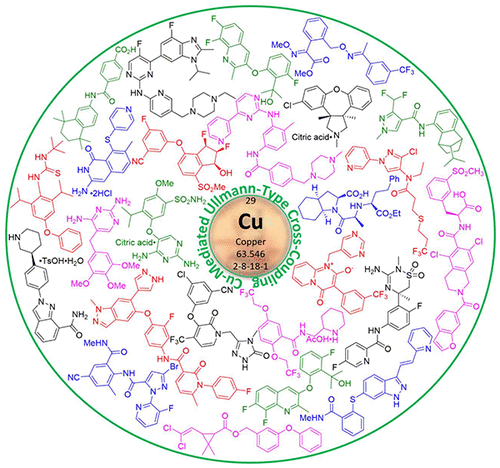当前位置:
X-MOL 学术
›
Org. Process Res. Dev.
›
论文详情
Our official English website, www.x-mol.net, welcomes your feedback! (Note: you will need to create a separate account there.)
Cu-Mediated Ullmann-Type Cross-Coupling and Industrial Applications in Route Design, Process Development, and Scale-up of Pharmaceutical and Agrochemical Processes
Organic Process Research & Development ( IF 3.1 ) Pub Date : 2022-05-24 , DOI: 10.1021/acs.oprd.2c00050 Qiang Yang 1 , Yinsong Zhao 2 , Dawei Ma 3
Organic Process Research & Development ( IF 3.1 ) Pub Date : 2022-05-24 , DOI: 10.1021/acs.oprd.2c00050 Qiang Yang 1 , Yinsong Zhao 2 , Dawei Ma 3
Affiliation

|
Cu-mediated Ullmann-type cross-coupling has experienced significant advances over the last century since the seminal publication by Ullmann in 1901. These advances have significantly expanded the scope of the original classical Ullmann coupling of aryl halides for formation of diaryl compounds to include the formation of carbon–heteroatom and other carbon–carbon bonds. The introduction of bidentate ligands drastically improved the performance of this class of transformations to enable milder reaction conditions that can tolerate a wide range of sensitive functional groups. Recent development of more powerful second-generation bidentate ligands has further allowed the coupling of less reactive aryl chlorides to proceed smoothly and realized low catalyst and ligand loadings for a broad scope of Ullmann-type cross-coupling reactions. As a result of these breakthrough advances in the past decades, Cu-mediated Ullmann-type cross-coupling reactions have been frequently implemented in academic research and have found ubiquitous industrial applications including the preparation of pharmaceutical and agrochemical products. This review provides an overview of selected general Cu-mediated Ullmann-type transformations for the formation of carbon–carbon and carbon–heteroatom (C–N, C–O, C–S, and C–P) bonds and their applications in route design, process development, and scale-up of pharmaceutical and agrochemical processes.
中文翻译:

铜介导的 Ullmann 型交叉偶联和工业应用在制药和农用化学品工艺的路线设计、工艺开发和放大
自 1901 年 Ullmann 开创性发表以来,Cu 介导的 Ullmann 型交叉偶联在上个世纪取得了重大进展。这些进展显着扩大了芳基卤化物形成二芳基化合物的原始经典 Ullmann 偶联的范围,包括形成碳-杂原子和其他碳-碳键。双齿配体的引入极大地提高了这类转化的性能,从而使反应条件更温和,可以耐受广泛的敏感官能团。最近开发的更强大的第二代双齿配体进一步使反应性较低的芳基氯化物的偶联能够顺利进行,并实现了广泛的 Ullmann 型交叉偶联反应的低催化剂和配体负载量。由于过去几十年的这些突破性进展,Cu 介导的 Ullmann 型交叉偶联反应经常在学术研究中实施,并已发现无处不在的工业应用,包括制备药物和农化产品。本综述概述了用于形成碳-碳和碳-杂原子(C-N、C-O、C-S 和 C-P)键的选定一般 Cu 介导的 Ullmann 型转变及其在路线中的应用制药和农用化学品工艺的设计、工艺开发和放大。Cu 介导的 Ullmann 型交叉偶联反应经常在学术研究中实施,并已发现无处不在的工业应用,包括制备药物和农化产品。本综述概述了用于形成碳-碳和碳-杂原子(C-N、C-O、C-S 和 C-P)键的选定一般 Cu 介导的 Ullmann 型转变及其在路线中的应用制药和农用化学品工艺的设计、工艺开发和放大。Cu 介导的 Ullmann 型交叉偶联反应经常在学术研究中实施,并已发现无处不在的工业应用,包括制备药物和农化产品。本综述概述了用于形成碳-碳和碳-杂原子(C-N、C-O、C-S 和 C-P)键的选定一般 Cu 介导的 Ullmann 型转变及其在路线中的应用制药和农用化学品工艺的设计、工艺开发和放大。
更新日期:2022-05-24
中文翻译:

铜介导的 Ullmann 型交叉偶联和工业应用在制药和农用化学品工艺的路线设计、工艺开发和放大
自 1901 年 Ullmann 开创性发表以来,Cu 介导的 Ullmann 型交叉偶联在上个世纪取得了重大进展。这些进展显着扩大了芳基卤化物形成二芳基化合物的原始经典 Ullmann 偶联的范围,包括形成碳-杂原子和其他碳-碳键。双齿配体的引入极大地提高了这类转化的性能,从而使反应条件更温和,可以耐受广泛的敏感官能团。最近开发的更强大的第二代双齿配体进一步使反应性较低的芳基氯化物的偶联能够顺利进行,并实现了广泛的 Ullmann 型交叉偶联反应的低催化剂和配体负载量。由于过去几十年的这些突破性进展,Cu 介导的 Ullmann 型交叉偶联反应经常在学术研究中实施,并已发现无处不在的工业应用,包括制备药物和农化产品。本综述概述了用于形成碳-碳和碳-杂原子(C-N、C-O、C-S 和 C-P)键的选定一般 Cu 介导的 Ullmann 型转变及其在路线中的应用制药和农用化学品工艺的设计、工艺开发和放大。Cu 介导的 Ullmann 型交叉偶联反应经常在学术研究中实施,并已发现无处不在的工业应用,包括制备药物和农化产品。本综述概述了用于形成碳-碳和碳-杂原子(C-N、C-O、C-S 和 C-P)键的选定一般 Cu 介导的 Ullmann 型转变及其在路线中的应用制药和农用化学品工艺的设计、工艺开发和放大。Cu 介导的 Ullmann 型交叉偶联反应经常在学术研究中实施,并已发现无处不在的工业应用,包括制备药物和农化产品。本综述概述了用于形成碳-碳和碳-杂原子(C-N、C-O、C-S 和 C-P)键的选定一般 Cu 介导的 Ullmann 型转变及其在路线中的应用制药和农用化学品工艺的设计、工艺开发和放大。














































 京公网安备 11010802027423号
京公网安备 11010802027423号